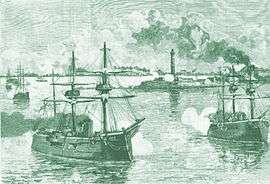HMS Condor (1876)
 "Well Done Condor". Bombardment of Alexandria, 1882 by Charles Dixon | |
| History | |
|---|---|
| Class and type: | Condor-class composite gunvessel |
| Name: | HMS Condor |
| Ordered: | 1875 |
| Builder: | Devonport Dockyard |
| Laid down: | 15 December 1875 |
| Launched: | 28 December 1876 |
| Commissioned: | 17 July 1877[1] |
| Fate: | Sold to George Cohen in August 1889 |
| General characteristics | |
| Displacement: | 774 tons |
| Length: | 157 ft (48 m) |
| Beam: | 29 ft 6 in (8.99 m) |
| Draught: | 12 ft (3.7 m)[2] |
| Installed power: | 772 ihp (576 kW) |
| Propulsion: |
|
| Sail plan: | Barque-rigged |
| Speed: | 11.5 kn (21.3 km/h) under power |
| Complement: | 100[2] |
| Armament: |
|
HMS Condor was the name-ship of the Royal Navy Condor-class composite gunvessel of 3 guns.[3]
Construction
Designed by Nathaniel Barnaby,[2] the Royal Navy Director of Naval Construction, her hull was of composite construction; that is, iron keel, frames, stem and stern posts with wooden planking. She was fitted with a 2-cylinder horizontal compound expansion steam engine driving a single screw, produced by John Elder & Co. She was rigged with three masts, with square rig on the fore- and main-masts, making her a barque-rigged vessel. Her keel was laid at Devonport Royal Dockyard on 15 December 1875 and she was launched on 28 December 1876.[2]
Career
Mediterranean Fleet
After commissioning on 17 July 1877, Condor joined the Mediterranean Fleet in 1879, remaining there until at least 1886.[1]
Bombardment of Alexandria
After rioting in Alexandria in which Europeans were killed, Admiral Seymour aboard HMS Invincible in company with a fleet of 15 ironclads arrived at Alexandria to protect the lives and property of British subjects. The local forces began work to improve the fortifications, and when they failed to respond to Seymour's ultimatum to stop work, a bombardment was begun.
Seymour signalled to Alexandra to commence firing at the Ras-el-Tin fortifications at 7:00 a.m. on 11 July 1882, followed by the general order to attack the enemy's batteries. The offshore squadron at first conducted the attack while underway, but this proved difficult, and by 9:40, Sultan, Superb and Alexandra had anchored off the Lighthouse Fort and concentrated their fire on Ras-el-Tin. By 12:30, Inflexible had joined the attack and the fort's guns were silenced.[4]
| “ | [A] steady cannonade was maintained by the attacking and defending forces, and for the next few hours the roar of the guns and the shrieks of passing shot and shell were alone audible." | ” | |
| — Royle[4] | |||
Meanwhile, Temeraire had taken on the Mex Forts and was causing damage to Mex when she grounded on a reef. Condor, commanded by Lord Charles Beresford, went to her assistance and she was refloated and resumed the attack. While the offshore squadron was engaging the forts at long-range, Monarch, Penelope and Condor were ordered into close engagements with the forts at Maza-el-Kanat and Fort Marabout. Condor sailed to within 1,200 feet of Fort Marabout and began furiously firing at the fort. When Fort Marabout's guns were disabled, the flagship signalled "Well Done, Condor." Condor's action allowed the ships to finish off Fort Mex.[4]

Fate
After a short career, Condor was sold to Mr George Cohen in August 1889.[2]
References
- Colledge, J. J.; Warlow, Ben (2006) [1969]. Ships of the Royal Navy: The Complete Record of all Fighting Ships of the Royal Navy (Rev. ed.). London: Chatham Publishing. ISBN 978-1-86176-281-8. OCLC 67375475.
- 1 2 "HMS Condor at the Naval Database website". Retrieved 9 February 2010.
- 1 2 3 4 5 6 Winfield, Rif & Lyon, David (2004). The Sail and Steam Navy List: All the Ships of the Royal Navy 1815–1889. London: Chatham Publishing. ISBN 978-1-86176-032-6. OCLC 52620555.
- ↑ "Condor class gunvessels at battleships-cruisers website". Retrieved 9 February 2010.
- 1 2 3 Royle, Charles (1900). The Egyptian Campaigns (1882–1885). London: Hurst and Blackett, Ltd. p. 606.